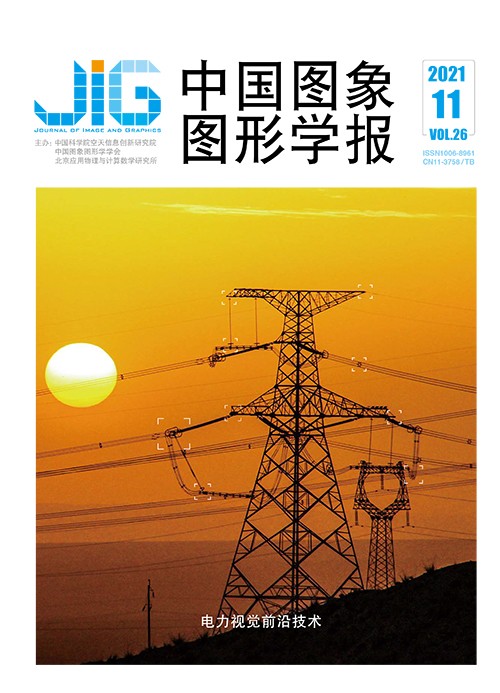
嵌入双注意力机制的Faster R-CNN航拍输电线路螺栓缺陷检测
戚银城1,2, 武学良1, 赵振兵1,2, 史博强1, 聂礼强3(1.华北电力大学电气与电子工程学院, 保定 071003;2.华北电力大学河北省电力物联网技术重点实验室, 保定 071003;3.山东大学计算机科学与技术学院, 青岛 266237) 摘 要
目的 螺栓是输电线路上最普遍、数量最多的部件,螺栓缺陷检测是输电线路视觉检测任务的一大难点。针对螺栓目标存在背景复杂、目标过小、不同类别之间差异小以及精细特征难以提取的问题,提出一种双注意力机制方法,分别对不同尺度和不同位置的视觉特征进行分析和增强。方法 对于不同尺度的特征,网络使用不同尺度的特征图计算出相应的注意力图,然后将相邻层的注意力图差异性作为正则化项加入网络中,从而增强螺栓区域的精细特征。对于不同位置的特征,先使用特征图计算出图像的空间注意力图,注意力图中每个元素表示两个空间位置的相似程度,然后利用注意力图将局部特征与全局特征融合,从而在全局视野上增强相似的区域,达到增大螺栓与背景的特征差异程度,实现提高螺栓区域的预测效果。结果 本文在航拍输电线路典型螺栓数据集上进行测试,与基线相比,结合双注意力机制的航拍输电线路螺栓检测方法的平均准确率提高了2.21%,其中正常螺栓类提升了0.29%,缺销螺栓类提升了5.23%,螺母缺失螺栓类提升了1.1%。结论 本文提出的基于双注意力机制的航拍输电线路螺栓缺陷检测方法取得了良好的效果,有效避免了螺栓缺陷检测中的误判漏判问题,为进一步对输电线路其他缺陷任务奠定了良好的基础。
关键词
Bolt defect detection for aerial transmission lines using Faster R-CNN with an embedded dual attention mechanism
Qi Yincheng1,2, Wu Xueliang1, Zhao Zhenbing1,2, Shi Boqiang1, Nie Liqiang3(1.School of Electrical and Electronic Engineering, North China Electric Power University, Baoding 071003, China;2.Hebei Key Laboratory of Power Internet of Things Technology, North China Electric Power University, Baoding 071003, China;3.School of Computer Science and Technology, Shandong University, Qingdao 266237, China) Abstract
Objective In transmission lines, bolts are widely used as a kind of fasteners to connect various parts of transmission lines and make the overall structure stable and safe. However, bolts are easily damaged because of their complex working environment. The damage or loss of a bolt may cause a large area of transmission line failure, which seriously threatens the safety and stability of the power grid. Bolts are the most common components of transmission lines. Thus, bolt defect detection is an important task in transmission line inspection. Good features are difficult extract because of the complex background, small target, small difference between categories, and loss of gradient information. This study proposes a dual-attention scheme to enhance the visual features of different scales and positions. Method First, for different scales, the network extracts the feature map of each layer, uses the multi-scale attention model to obtain the corresponding attention map, calculates the difference of the attention map for adjacent layers, and adds it to the loss function as a regularization term to enhance the fine features of the bolt area. The trained network continuously reduces the difference in the attention maps of different layers. The learned attention maps of different scales are introduced into the network as a kind of context information. This procedure can avoid the loss of important information in the process of feature extraction. No additional regulatory information is required because the attention map is from the network itself. Second, for different positions, bolts appear in specific positions of the accessories, but due to light blocking and other reasons, the characteristics of these positions are not obvious. In this study, we use the feature map to derive a spatial attention map of the image. Each element in the attention map indicates the degree of similarity between two spatial locations. Then, the attention map is used to combine the features of each position with the global feature. This process enhances the features in similar regions and improves the difference degree between dissimilar areas. Hence, the difference between the bolt and the background is increased, and the detection accuracy of the bolt area is improved. Result The method is tested on a typical bolt data set for aerial transmission lines. The typical bolt data set contains 1 483 images of three types of bolts. Each image has a size of approximately 3 000×4 000 pixels. A total of 2 692 targets are labeled, and they include 1 443 normal bolt samples, 670 missing bolt samples, and 579 missing nut bolt samples. The ratio of the training set to the test set is 8:2. The baseline model used in this study is the faster region convolutional neural network(Faster R-CNN) model. Experimental results show that compared with the baseline, the proposed model's mean average precision (mAP) is increased by 0.29% when the multi-scale attention module is added. Normal, missing and missing nut bolts increase by 0.62%, 2.54%, and 0.69%, respectively. After the addition of the spatial attention module, the mAP of the model increases by 0.61%; specifically, the AP of normal bolts increases by 0.3%, that of missing bolts increases by 2.05%, and that of missing nut bolts increases by 0.52%. This result is obtained because several shaded nuts of missing bolts are confused with the nuts of normal bolts, leading to misjudgment. After introducing multi-scale attention and spatial attention at the same time, the model's mAP is increased by 2.21%; the AP of the normal, missing, and missing nut bolts is increased by 0.29%, 5.23%, and 1.10%, respectively. These experimental results prove the effectiveness of the bolt defect detection method for aerial transmission lines based on the dual attention mechanism. This study also conducts visualization experiments, including the establishment of feature maps, model training loss function curve, precision-recall(PR) curve, and bolt defect detection result map, to prove that the proposed method can be applied to feature extraction. Conclusion Experimental results prove that the proposed detection method for aerial transmission line bolt defects based on the dual attention mechanism is effective. The process of supervising feature extraction can ensure that abundant useful information is retained when extracting features. For the bolt defect detection task, increasing the difference between the target and the background can improve the detection accuracy of the target area. The visualization experiments verify that the proposed method can retain abundant useful information in the process of feature extraction. The visualized test examples also prove that the proposed method can effectively avoid the problem of misjudgment in bolt defect detection.
Keywords
|



 中国图象图形学报 │ 京ICP备05080539号-4 │ 本系统由
中国图象图形学报 │ 京ICP备05080539号-4 │ 本系统由